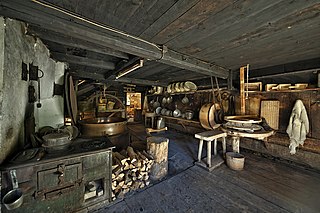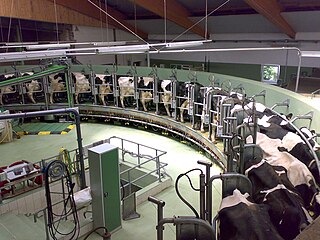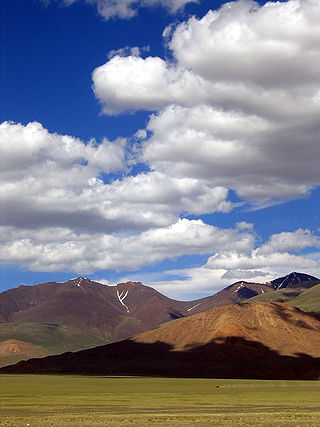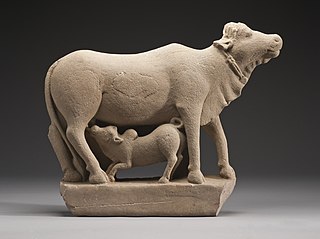Related Research Articles

A dairy is a place where milk is stored and where butter, cheese and other dairy products are made, or a place where those products are sold. It may be a room, a building or a larger establishment. In the United States, the word may also describe a dairy farm or the part of a mixed farm dedicated to milk for human consumption, whether from cows, buffaloes, goats, yaks, sheep, horses or camels.

Animal husbandry is the branch of agriculture concerned with animals that are raised for meat, fibre, milk, or other products. It includes day-to-day care, management, production, nutrition, selective breeding, and the raising of livestock. Husbandry has a long history, starting with the Neolithic Revolution when animals were first domesticated, from around 13,000 BC onwards, predating farming of the first crops. During the period of ancient societies like ancient Egypt, cattle, sheep, goats, and pigs were being raised on farms.

The Holstein Friesian is an international breed or group of breeds of dairy cattle. It originated in Frisia, stretching from the Dutch province of North Holland to the German state of Schleswig-Holstein. It is the dominant breed in industrial dairy farming worldwide, and is found in more than 160 countries. It is known by many names, among them Holstein, Friesian and Black and White.

Dairy farming is a class of agriculture for the long-term production of milk, which is processed for the eventual sale of a dairy product. Dairy farming has a history that goes back to the early Neolithic era, around the seventh millennium BC, in many regions of Europe and Africa. Before the 20th century, milking was done by hand on small farms. Beginning in the early 20th century, milking was done in large scale dairy farms with innovations including rotary parlors, the milking pipeline, and automatic milking systems that were commercially developed in the early 1990s.

Dairy cattle are cattle bred with the ability to produce large quantities of milk, from which dairy products are made. Dairy cattle generally are of the species Bos taurus.
There are different systems of feeding cattle in animal husbandry. For pastured animals, grass is usually the forage that composes the majority of their diet. In turn, this grass-fed approach is known for producing meat with distinct flavor profiles. Cattle reared in feedlots are fed hay supplemented with grain, soy and other ingredients to increase the energy density of the feed. The debate is whether cattle should be raised on fodder primarily composed of grass or a concentrate. The issue is complicated by the political interests and confusion between labels such as "free range", "organic", or "natural". Cattle raised on a primarily foraged diet are termed grass-fed or pasture-raised; for example meat or milk may be called grass-fed beef or pasture-raised dairy. The term "pasture-raised" can lead to confusion with the term "free range", which does not describe exactly what the animals eat.
The BAIF Development Research Foundation is a NGO based in Urali Kanchan near Pune in Maharashtra, India, that pioneers agricultural development. It was founded in 1967 by Manibhai Desai as the Bharatiya Agro Industries Foundation. Under Manibhai, BAIF pioneered cross breeding of high yielding European cattle such as Holstein Freisian and Jersey with the sturdy Indian breeds such as Gir from Gujarat. Later BAIF expanded the scope of activities to include animal health, nutrition, afforestation wasteland development, and tribal development.

Agriculture in Mongolia constitutes over 10% of Mongolia's annual gross domestic product and employs one-third of the labor force. However, the high altitude, extreme fluctuation in temperature, long winters, and low precipitation provides limited potential for agricultural development. The growing season is only 95 – 110 days. Because of Mongolia's harsh climate, it is unsuited to most cultivation.

Many farmers in India depend on animal husbandry for their livelihood. In addition to supplying milk, meat, eggs, wool, their castings (dung) and hides, animals, mainly bullocks, are the major source of power for both farmers and dairies. Thus, animal husbandry plays an important role in the rural economy. The gross value of output from this sector was 8,123 billion Rupees in FY 2015–16.

National Dairy Research Institute (NDRI) is India's premier institute for dairy research, established in 1955, located in Karnal, Haryana, having been accorded with the status of Deemed University since 1989. NDRI operates under the aegis of Indian Council of Agricultural Research.
In Sri Lanka many farmers depend on animal husbandry for their livelihood, but not a large proportion. Therefore, many livestock products have to be imported. The main livestock products in Sri Lanka are milk, meat and eggs. Hides, wools and other products are still not produced within the country. Animal power formerly used in the cultivation of rice and vegetables have been replaced by modern technology to farmlands. However animal husbandry plays an important role in the rural economy for improving the living conditions of farmers in the country.

Livestock are the domesticated animals raised in an agricultural setting in order to provide labour and produce diversified products for consumption such as meat, eggs, milk, fur, leather, and wool. The term is sometimes used to refer solely to animals who are raised for consumption, and sometimes used to refer solely to farmed ruminants, such as cattle, sheep, and goats. Horses are considered livestock in the United States. The USDA classifies pork, veal, beef, and lamb (mutton) as livestock, and all livestock as red meat. Poultry and fish are not included in the category. The latter is likely due to the fact that fish products are not governed by the USDA, but by the FDA.

Cattle are large, domesticated, bovid ungulates widely kept as livestock. They are prominent modern members of the subfamily Bovinae and the most widespread species of the genus Bos. Mature female cattle are called cows and mature male cattle are bulls. Young female cattle are called heifers, young male cattle are oxen or bullocks, and castrated male cattle are known as steers.
GADVASU) was established with the objective of promoting livestock production, health and prevention of diseases through integrated teaching and extension programs in related fields. It is located at Ludhiana, in Punjab and aims to serve the rural people of Punjab by improving their quality of life and producing specialists within them.

Being a country that has a largely rural and agriculture-based industry, animal husbandry plays an important role in the economy of Pakistan and is a major source of livelihood for many farmers. Between 30 and 35 million people in Pakistan's current labour force are estimated to be engaged in livestock rearing. While the agricultural practice is prevalent throughout the entire country, it is more common in the fertile provinces of Punjab and Sindh, which are traditionally the main areas of agriculture and farming activity. In 2020, the livestock industry contributed 60.6% to overall agriculture and 11.7% to the GDP.

The Department of Animal Husbandry, Dairying and Fisheries is one of the departments of Government of Tamil Nadu. The departments encompasses the departments of animal husbandry, fisheries, milk production and dairying.
Kamdhenu Yojna is a dairy scheme introduced in the year 2013 in Uttar Pradesh to surpass the low availability of high yielding germ plasm animals in Uttar Pradesh. Its Kamdhenu, Mini Kamdhenu and Micro Kamdhenu version were started by the Animal husbandry department of Uttar Pradesh Government. The state government has launched Kamdhenu Dairy Scheme which envisions establishment of 100 high yielding animal units sourced from outside Uttar Pradesh. Entrepreneurs are provided with interest free loan and subsidy. Through the scheme more than 1000 dairy farms of 100, 50 and 25 cattle have been established in Uttar Pradesh. National Dairy Plan (NDP) of the National Dairy Development Board (NDDB) comes under the unit of Uttar Pradesh.

Dairy plays a significant part in numerous aspects of Indian society, including cuisine, religion, culture, and the economy.

The Department of Animal husbandry and Dairying (DAHD) is an Indian government department. It is a subsidiary department of the Ministry of Animal Husbandry, Dairying and Fisheries which was formed as a new Indian ministry in 2019. The DAHD or the erstwhile Department of Animal husbandry, Fishiries and Dairying was formed in 1991 by merging together into a separate department, of two divisions of Department of Agriculture and Cooperation, namely animal husbandry and dairy development. In 1997 the fisheries division of Department of Agriculture and Cooperation and a part of the Ministry of Food Processing Industries was transferred to it. In February 2019 the Department of Fisheries was carved out from the Department of Animal husbandry, Dairying and Fisheries and it has been functioning as Department of Animal Husbandry and Dairying since then.
The National Veterinary Research Institute (NVRI) is a research institute in Nigeria that was established in 1924 and has the mandate to conduct research into how to ably identify, treat and control animal diseases as well as the development of vaccines for such and training and the provision of support services to livestock and poultry farmers. The institute is under the supervision of Federal Ministry of Agriculture and Rural Development. The chief executive is Maryam Muhammad, a veterinary doctor with research interests in the molecular epidemiology of Salmonella in poultry, public health and environment and development.